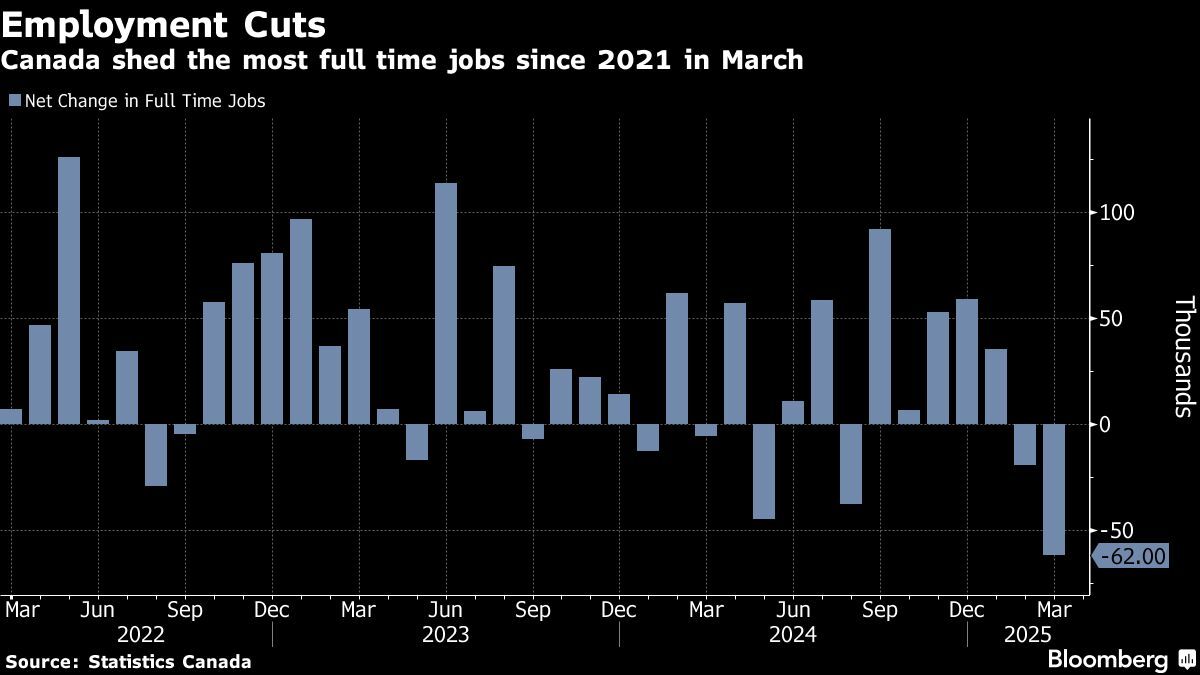
Statistics Canada reported on Friday that employment fell by 33,000 positions last month, pushing the jobless rate up 0.1 percentage point to 6.7%, marking the first job loss in eight months, and the largest since January 2022.
(April 4): Canada’s labour market unexpectedly weakened in March, shedding the most jobs in more than three years.
Employment fell by 33,000 positions last month, pushing the jobless rate up 0.1 percentage point to 6.7%, Statistics Canada reported on Friday. Economists in a Bloomberg survey were expecting the economy to add 10,000 jobs, with unemployment rising to 6.7%.
That marked the first job loss in eight months, and the largest since January 2022, following a tepid increase of 1,100 in February. Net employment creation in the first quarter was about 44,000, three times smaller than that of the final quarter of last year.
The threats and implementation of US President Donald Trump’s tariffs, as well as Canada’s retaliating levies, appear to have weighed on the Canadian jobs market over the past two months. But with the country dodging the latest round of so-called reciprocal tariffs this week, the Bank of Canada may have more time to weigh economic weakness against rising price pressures.
Statistics Canada released the report at the same time as US data showed job growth in the country beat forecasts in March and the unemployment rate edged up, pointing to a healthy labor market before the global economy gets hit by widespread tariffs.
Canadian bonds rallied, sending the yield on two-year benchmark government notes to 2.27% as of 8.45am Ottawa time — the lowest since March 2022. The loonie extended losses to trade around C$1.423 per US dollar. Traders in overnight swaps boosted bets that the Bank of Canada will cut rates at its next meeting April 16, to more than 60% from around 35% on Thursday.
March’s employment decline was driven by a drop in full-time work — the largest since 2021 — and in the private sector. While there’s no clear signs of widespread layoffs yet, trade-exposed sectors appeared to drive some of the declines.
Wholesale and retail trade, culture and recreation, business support services, agriculture and manufacturing led job losses.
“This is the worst full-time print in four years. And one of the worst ever,” Rishi Mishra, an analyst at Futures First Canada Inc, said in an email.
The numbers suggest “a relatively-positive early-year growth handoff is running out of steam,” said Karl Schamotta, chief market strategist at Corpay.
“Although the country escaped getting hit during Trump’s latest round of tariffs, levies are now in place on several of the country’s most important export categories, work stoppages are underway at auto plants, commodity prices are still under pressure, and a broad swath of industries remains vulnerable to a downturn in US demand,” he said.

Governor Tiff Macklem and his central bank policymakers have signalled they won’t rush into making a decision until they can get a better read of the economy and inflation amid the tariff war. The majority of economists expect a pause in their easing campaign at their next meeting after seven consecutive rate cuts.
“The wheels may be starting to fall off the Canadian labour market,” Andrew Grantham, economist at Canadian Imperial Bank of Commerce, said in a report to investors.
“Today’s report was clearly weaker than expected, although next week’s Bank of Canada surveys and global risk sentiment will also be key in determining whether the bank continues to cut interest rates or elects to skip a meeting later this month,” he said, referring to business and consumer outlook surveys set to be released by the central bank on Monday.
Regionally, employment fell in Ontario and Alberta, with losses in the latter province concentrated in manufacturing and wholesale and retail trade. Saskatchewan added jobs while employment was little changed in other provinces.
“The deterioration of the labour market maybe be signalling the start of a possible recession in Canada due to the US tariffs,” Charles St-Arnaud, chief economist at Alberta Central, said in an email. “This complicates the Bank of Canada’s job going into the April meeting. On one hand, the economy is slowing rapidly while, on the other hand, inflationary pressures have been more elevated than expected in recent months.”
Inflation data for March set to be released a day before the central bank’s next meeting may be the deciding factor for a cut or a hold, St-Arnaud said.
With the labour market loosening, yearly wage growth for permanent employees decelerated to 3.5%, versus economist expectations of 4.1% and down from 4% in February.
Total hours worked rose 0.4% in March, following a decline of 1.3% a month earlier.
The employment rate — the proportion of the working-age population that’s employed — fell 0.2 percentage points to 60.9%. This partially wiped out a 0.3 percentage-point increase between October and January.
Uploaded by Felyx Teoh
- Majujaya files petition to wind up Bina Puri for failure to pay RM30m awarded by court
- Pak Lah, the gentleman of politics, passes away at 85
- Zarul Ahmad now says his firm received distinct advantage from Guan Eng in bid for Penang undersea tunnel project
- Malaysia will have to rely more on domestic demand as trade tensions threaten exports, economists say
- Maybank CEO’s term extended, lender to move to Merdeka 118 from 2Q2026
- Malaysia declares state funeral for Tun Abdullah Ahmad Badawi
- LVMH posts 3% drop in sales as core business slumps
- Financial crisis is one scenario in US trade war, says Scope Ratings
- China suppliers mock tariffs with Nike, Lululemon deals on TikTok
- Treasuries snap five-day selloff as tariff reprieve lifts stocks

